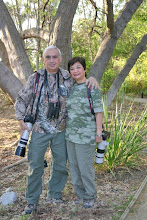When our friend Maia reported seeing an Eyebrowed Thrush in her blog, my wife and I decided to twitch it first thing on Saturday. The sun had barely risen from the horizon and we were already walking towards the MacArthur palm tree where the thrushes feast on the red fruits. As soon as we saw the tree there was a big bird perched on its branch - brownish with a plumage that resembled the scales of a fish.
"White's Thrush!" I whispered to Cynthia as I plunked down my gear and started firing away. My wife did the same. Then "poof" it left without even a whisper. I stationed myself behind the bushes and waited for the bird's return. Minutes went slowly by. My wife's patience ran out and she decided to explore the mini-forest. More minutes slowly went by. The treetops glowed from the brilliant morning sun. Still no thrush - not the scaly, not the ashy and definitely not the one with the eyebrow that I was fervently hoping to see.
I joined my wife in exploring the small patch of forest at La Mesa Ecopark and surprisingly didn't see much. No Ashy Thrushes rushing at my feet nor young Red-bellied Pittas by my tripod. Or anywhere in sight. At all!
Sounds from the representatives of the Columbidae family filled the air. We even got some distant sightings of a few of them: a Philippine Cuckoo-dove(!), the White-eared Brown Dove, even the skulky Common Emerald Dove and of course, Zebra Doves.
Then there were those conniving Philippine Coucals who, as soon as we spotted one, would immediately dive into the underbrush and became invisible.
We met fellow birder, Mark Jason Villa, who was leading a group of foreign birders. He told us that they did see the Ashy Thrush and the Red-bellied Pitta right by the entrance into the main trail. This was confirmed by another fellow birder, Sean Melendres, who we met a few minutes later.
My wife and I proceeded to the area mentioned by these two friends. And saw nothing! Perhaps it was because there were several bikers that passed by - grunting as they pedaled up the trail. Sighing, I told Cynthia that we should try the fruiting palm trees again and maybe, you know, an Eyebrowed Thrush might be there.
It was deja vu. As we approached the tree a big bird flew in and perched on its branch - brownish but sadly without an eyebrow. It did have scaly featherings though. Sean, who was already staking out the place started taking the picture of the White's Thrush - as I did. After quite some time, having gorged on the bountiful fruit, the big bird eventually flew away.
It was time to go home. We decided to take the main trail still hoping to encounter the regular denizens of the mini-forest. Cynthia who was walking ahead of me suddenly stopped, pointed at something moving in the dark understory on our left. Finally, we saw the what used to be the immature Red-bellied Pitta now sporting the bright green and red coloring of a mature bird.
It was not that birdy that Saturday morning. We dipped on our target bird. However, we were heavily compensated by the cooperative White's Thrush. The field guides that I consulted both stated that this particular thrush was "somewhat secretive and solitary on the ground or in the understory (Kennedy, et al) and "very shy, often flushed from ground" (Robson). As a matter of fact that's how we saw it last year. So it was a surprise to see it feeding on a palm tree and out in the open even.
To those who are curious as to how it was called such - this species was recently split from the Scaly Thrush (Zoothera dauma) and was named after the English naturalist Gilbert White and not because of its color.





No comments:
Post a Comment